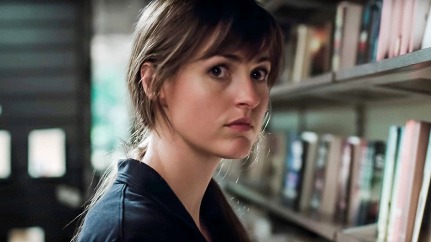 A film from Norway about a young woman seeking fulfillment in relationships takes the conventions of romantic comedy and turns them over to reveal the male-centered trap underneath.
A film from Norway about a young woman seeking fulfillment in relationships takes the conventions of romantic comedy and turns them over to reveal the male-centered trap underneath.
The Worst Person in the World. Now, there’s a title that will get your attention. But this new film from Norwegian director Joachim Trier is named ironically. It’s not a portrait of an evil person at all, but of someone who is set up by the world she lives in to blame herself for everything.
Julie, a medical student played by the excellent Renate Reinsve, suddenly realizes that she doesn’t want to be a doctor after all, but would rather study the mind, in other words, become a psychologist. Then she changes her mind again and says she will pursue photography. As an audience, we might be tempted to see her as flaky, but the film makes us see that this kind of wavering is normal for someone in their 20s, especially someone in the upper middle class. The one element that does disturb Julie’s focus is romance. Once again, normal. She loves the initial very blissful stage of connection with an attractive man, and of course this element includes sex, a pleasure that we all know is powerful. The subtle point we’re made to realize is that the unspoken but real male social dominance makes it harder for women to navigate career and romance, and the one aspect the film beautifully portrays is how relationships inevitably become about the man’s thoughts, desires, and overall narratives; automatically relegating women to a supporting role. This all might sound rather dry when I describe it, but Trier and his screenwriter, Eskil Vogt, weave a remarkably observant portrait of people trying to navigate the rules of the game, and Reinsve’s performance is a constant revelation of female intelligence, desire, and frustration.
Julie gets into a relationship with a well-known artist who is fifteen years her senior. The enjoyment of each other’s company is genuine, but she ends up feeling like a spectator of her own life. She eventually cheats on him with a married man she meets at a wedding reception that she’s crashed, but rather than take this plot development for granted, the film beautifully conveys the gradual stages, from initial flirting while feeling a sense of taboo, to final acceptance of the need to be together, the peak being a long brilliant sequence in which everyone in the world stops in a freeze-frame while Julie runs through all these stationary figures to see her new lover.
But we know—and this is another clever thing—that the same contradictions will arise again. When I thought about the film’s clear-eyed view of patriarchy, I considered opening this review by saying, “What if Woody Allen were a feminist?” But that’s actually selling this movie short. Yes, it’s written and directed by men, and it doesn’t have a radical style, but I rarely see films in which the intricacies of love, sex, and relationships in a male-dominated world, are so finely and compassionately exposed. The men in the film are not depicted as bad people, even though we know such men exist. Instead, everyone in this story is well-meaning, trying their best, but it’s the unconscious assumptions and unspoken rules that are driving everything.
The ads and previews try to tell us that this is a romantic comedy. Well, OK, but if so, it’s the least consoling rom-com I’ve ever seen. It’s frequently funny, but there are no jokes or gags. The humor springs from anxiety and loss. The Worst Person in the World, with its mocking title and lovely main character, may seem light-hearted on the surface, but it carries the weight of disappointed dreams.

The best film of 2013 may have been something I didn’t see, or didn’t even have a chance to see. There’s a wealth of...

Dallas Buyers Club takes us back to the early period of the AIDS epidemic, when ignorance and homophobia stood in the way of progress...

2017 was a horrible year, but the year in film wasn’t too bad. Chris Dashiell names his favorite 2017 releases. It’s that time of...